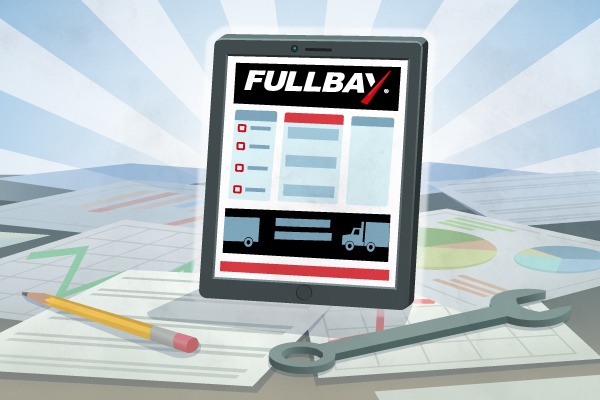6 Critical Reasons You Should Have Shop Repair Software

Using shop repair software is no longer optional. Commercial repair shops are busy places. Information flows through them like crazy. Data like repair requests, preventive maintenance tracking, parts ordering, estimates, customer authorizations, invoices. Many shops continue to use paper to track all this information. Or, they use a legacy repair shop software system that requires them to print out paper work orders. Any of these shops that don’t adopt modern shop repair software put themselves at a severe disadvantage.
Shop Repair Software in the Information Age
When running a repair shop, information is money. With the fast pace of a repair operation, if you don’t capture information the moment it’s produced, there is a huge risk you’ll lose it in the shuffle. Here are six critical reasons you should have shop repair software.
1. Repair request
The actual repair request, including the specific words the customer used when calling in the request. If the customer calls up on the phone, and the person who takes the call scribbles information down on a piece of paper, you lose a lot of information. You can only capture so much. This applies especially when both parties are in a rush.
Consider this: the average person speaks 150 words per minute, but can only write 13 words per minute. If a customer calls up on the phone with a repair request, the person answering will lose on average 90% of what is said. Yes, there will be some repeating, and some clarifying questions. But transferring information from a phone call to paper is terribly inefficient and results in tremendous information loss. Yet so much repair shop software on the market relies on filling out paper forms! The sad truth is that in many parts of the commercial repair industry, this is just considered acceptable as the norm.
There is some repair shop software that allows you to type directly into the repair request. While this is a big improvement over handwriting, the average person still only types 40 words per minute. That’s still a loss of more than 70%.
And the problem isn’t just not being able to keep up with what is said. The “telephone game” is a classic example of how a message gets garbled when one person passes it to the next. A group of people sit in a circle, and the first person in the group whispers something to their neighbor. The neighbor then whispers what they heard to their neighbor, and so on. By the time the message gets to the last person, it has often completely lost its original meaning.
But what if the customer were able to input the repair request themselves? Look for shop repair software that allows this. In a system like this, there is 100% capture of what the customer says. Not only that, but the customer gets the emotional release of being able to write down exactly what the issue is, and know that the tech will see exactly what they wrote.
What’s more, there is a phenomenon where writing something down helps the writer to organize their thoughts. Flannery O’Connor said, “I write because I don’t know what I think until I read what I say.” Not only is nothing lost, the message itself will usually be more clear and succinct if the customer is given the chance to write it themselves.
2. Preventive maintenance tracking
Hundreds of thousands of fleets in North America still use paper and spreadsheets to track their preventive maintenance. When they remember a PM or DOT/CVIP is due, they’ll reach out to a repair shop to get it done. In practice, DOTs expire more often than fleet managers want to admit, and PMs go past due far too frequently.
Repair shops have a massive opportunity to take advantage of this current reality. They can use shop repair software to proactively track PMs and inspections for their customers, the fleets. At Fullbay, we evangelize to shops that they should track PMs for their customers using our repair shop software.
3. Parts ordering
Good technicians are very hard to come by. When you find a good tech, you’d be crazy not to make the best use of their time as possible. Unfortunately, there are some big inefficiencies in most shops that require the techs, in this day and age, to perform very menial tasks.
For example, when a technician starts in on a repair, most shops provide the tech with a piece of paper to write down what parts he needs. At some point, that tech will take the time to physically walk the piece of paper over to someone else who will then deal with ordering the parts or pulling them from inventory. (Or the tech may have to order the parts themselves–for a later discussion.) Later on in the process, another person will then have to translate the tech’s handwriting into something that is clean and makes sense on the customer’s invoice.
Much better to use shop repair software to capture that information from the tech the moment it becomes available. Put a tablet in the hands of the tech. Allow them to type, or speak, the part list. It then instantly becomes available for the parts manager for ordering parts, and the office manager for invoicing the customer later.
4. Estimates
In an ideal world, you would have a tight relationship with every customer, and they would trust you to only do necessary repairs and charge a fair price. The customer in turn would pay their invoices promptly, and with no questions asked.
In the real world, we often have to:
- Create estimates, then
- Get a purchase order number, and
- Deal with third party fleet managers like ARI, Donlen, Warner, Wheels, FleetNet, and others.
And you better be sure to build that estimate accurately! Because if the actual repair bill comes in higher than the estimate, buckle up. Not only will you go through the whole authorization process again; you run the risk of the customer not paying any extra because they did not authorize it.
You can build estimates by hand, with a spreadsheet, or directly in QuickBooks. Writing out service descriptions and part names isn’t difficult. Putting in dollar amounts isn’t either. What’s tough is all the work that goes into figure out what parts actually will be needed, how much they’ll cost, and how we should mark them up. You also need to know how many hours a repair should take, what the book rate says, and whether your tech can actually get it done in that amount of time.
All of this takes time. And this is one of the Big 3 reasons for tech inefficiency: waiting around for a customer to authorize a repair. The truck’s taking up space in the bay, or the tech is waiting with it on the side of the road or at the customer’s yard. Do we just barrel ahead with the repair and send in the estimate later, when the repair is done? And then cross our fingers the customer authorizes it? Or do we wait?
There’s a third way. You can build an estimate extremely fast. And this is where repair shop software can help, big time. By capturing data like the parts list, vendor quotes, and the tech’s diagnosis in-stream, good software like Fullbay creates the estimate for you. You then become the editor to tweak hours here and there, clean up wording, and maybe change some parts markups.
5. Authorizations
Have you ever gotten a verbal authorization from a customer, done the repair, sent the invoice, then the customer says “I didn’t authorize that repair”? It happens to everyone. You hope the customer pays in full, but often you end up haircutting the invoice. And any haircut comes straight out of profits. (Remember the adage: $100 becomes a big deal when you realize a shop with a 10% profit has to do $1000 worth of work to make up for a $100 haircut.)
Shop repair software helps with this too. Look for software that allows you to not only document a verbal authorization, but easily send an email to the customer recapping what they just authorized. Simple steps like shining a light on the authorization process virtually eliminates invoice disputes. No more invoice haircuts.
6. Invoices
In the paper world, creating a repair invoice can take upwards of 30 minutes when you add it all up. That’s because the person doing the invoice has to do a lot of checking, cross checking, addition, multiplication, deciphering chicken scratch, editing, creative writing, tracking down missing vendor bills, and more. Sound familiar? Many shops have full time employees who do nothing but create customer invoices.
There is a lot that can go wrong. If you forget to bill a part, it can be tough to get the customer to pay for it later. If you mark up a part wrong, you’ll never get that back. The tech may have done a repair you don’t know about, and you might severely under bill a job. A small note written on the paper work order could represent several hours of billable work. And so on and so on.
All the more reason you should capture these critical pieces of information in-stream, the moment they become available. This is possible with the right repair shop software. And the miracle is, it means you can invoice in a few seconds, versus in 30 minutes or more. Because the repair shop software captured all the information you needed along the way.
Repair shop software for the modern shop
Repair shop software is no longer optional. Your busy commercial truck shop needs shop management software. It puts you at a clear advantage over your competitors and your customers see you adapting to the modern age. You will capture information as it flows, and make your shop more efficient than it’s ever been.

